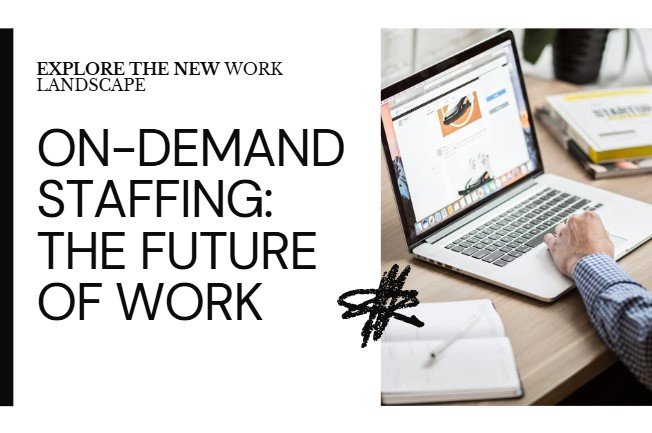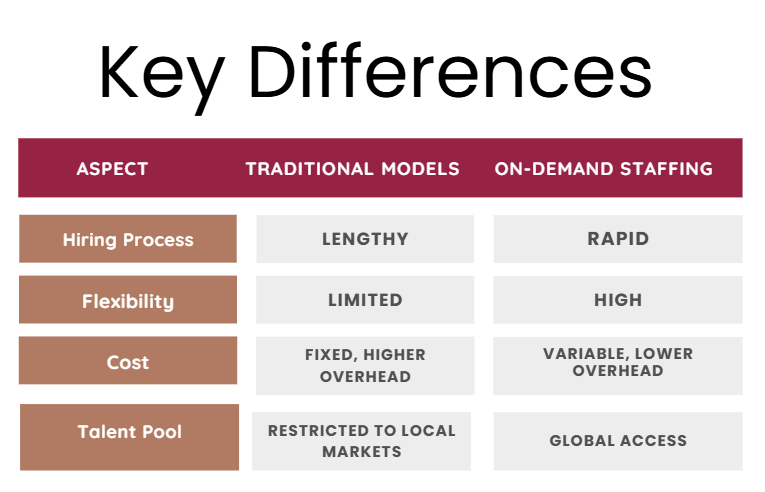
The modern workplace is undergoing a transformation. With the rise of technology, shifting employee expectations, and evolving business needs, traditional 9-to-5 work models are being challenged. One of the most significant trends contributing to this evolution is the adoption of on-demand staffing. This innovative approach to workforce management offers unparalleled flexibility, cost efficiency, and access to a diverse talent pool. As companies prioritize agility and employees seek better work-life flexibility, the question arises: Is the traditional work model dead?
What Is On-Demand Staffing?
On-demand staffing connects employers with skilled professionals for short-term, project-based, or flexible roles. Unlike traditional hiring methods, which often involve lengthy processes, on-demand workforce platforms like Vurke streamline recruitment through technology, ensuring businesses can meet their immediate needs efficiently. This model is prevalent in industries like tech, healthcare, logistics, and creative services, where demands fluctuate frequently.
The rise of platforms such as Upwork, Fiverr, and TaskRabbit illustrates the growing popularity of this staffing approach. With AI-driven algorithms and predictive analytics, companies can now match specific skill sets with open positions within minutes.
The Appeal of On-Demand Staffing
For Employers
- Flexibility: Easily scale your team up or down depending on project requirements.
- Cost Efficiency: Save on full-time salaries, benefits, and office space.
- Diverse Talent Pool: Access specialists worldwide, ensuring you get the best fit for every task.
- Enhanced Productivity: Focus on outcomes rather than hours worked.
For Employees
- Work-Life Flexibility: Choose when and where to work, creating a schedule that aligns with personal priorities.
- Skill Enhancement: Take on varied projects that expand professional expertise.
- Autonomy: Enjoy greater control over career paths without being tied to one employer.
Industries Leading the Way
Several industries are adopting on-demand staffing at an impressive pace:
- Technology: Startups and established tech firms alike benefit from hiring developers, designers, and data analysts on a project basis.
- Healthcare: Temporary nurses, medical technicians, and telehealth professionals fill critical gaps during emergencies or surges.
- Logistics: Seasonal demand in e-commerce requires flexible staffing solutions to manage shipping and inventory.
Traditional Models vs. On-Demand Staffing
Traditional hiring typically involves long-term contracts, fixed salaries, and stringent schedules. On the other hand, on-demand staffing offers flexibility, performance-driven compensation, and dynamic work arrangements. While traditional models provide stability, they often lack the adaptability needed in today’s fast-paced world.

Accelerated Time-to-Market
The traditional 9-to-5 workday is increasingly being questioned. Younger generations value purpose-driven work, flexibility, and autonomy over rigid schedules. Additionally, globalization, automation, and workforce demands are accelerating the shift toward hybrid and on-demand models.
Companies that cling to outdated models risk falling behind competitors who embrace innovation. The rise of the hashtag #worktrend highlights this cultural pivot. Employees now demand workplace practices that cater to their lifestyles while delivering business results.
Challenges in On-Demand Staffing
Despite its advantages, on-demand staffing is not without challenges:
- Job Security: Workers may face income instability without consistent gigs.
- Lack of Benefits: Freelancers often miss out on health insurance and retirement plans.
- Exploitation Risks: Inadequate regulations can leave workers vulnerable.
Employers and policymakers must collaborate to create frameworks that balance flexibility with security.
Is the 9-to-5 Workday Obsolete?
The 9-to-5 workday, a hallmark of traditional employment, is increasingly viewed as outdated. Employees today prioritize flexibility and efficiency over clocking hours at a desk. While the model worked well during the industrial era, it clashes with the digital age’s demands.
On-demand workforce solutions align better with modern lifestyles, offering personalized schedules and freedom. However, not all roles can shift away from this structure, such as manufacturing or retail jobs. A hybrid model combining the best of both worlds may emerge as the ultimate solution.
Future Projections for On-Demand Staffing
Experts predict significant growth in the on-demand workforce over the next decade. By 2030, nearly 50% of the U.S. workforce may engage in flexible work arrangements. Advancements in AI and automation will further streamline this model, making it even more accessible and efficient for businesses and professionals alike.
Conclusion
On-demand staffing is more than just a trend, it’s a revolution in reshaping how we work. As traditional models face growing pressure to evolve, businesses and professionals alike are discovering the benefits of this flexible approach. While challenges remain, the future of work is undoubtedly moving toward agility, innovation, and personalization.
FAQs
What is on-demand staffing?
On-demand staffing involves hiring skilled workers on a temporary or project basis, often through digital platforms, for greater flexibility and cost efficiency.
How does on-demand staffing benefit businesses?
It allows businesses to scale efficiently, reduce costs, and access global talent pools while focusing on performance-driven outcomes.
Are traditional work models dead?
While not entirely obsolete, traditional models face significant challenges and are being supplemented or replaced by flexible alternatives like on-demand staffing.
Which industries benefit most from on-demand staffing?
Technology, healthcare, logistics, and creative services are among the industries thriving with on-demand workforce models.
Is the 9-to-5 workday obsolete?
For many, yes. The digital age demands flexibility, making the 9-to-5 schedule less relevant, though some industries still rely on it.

